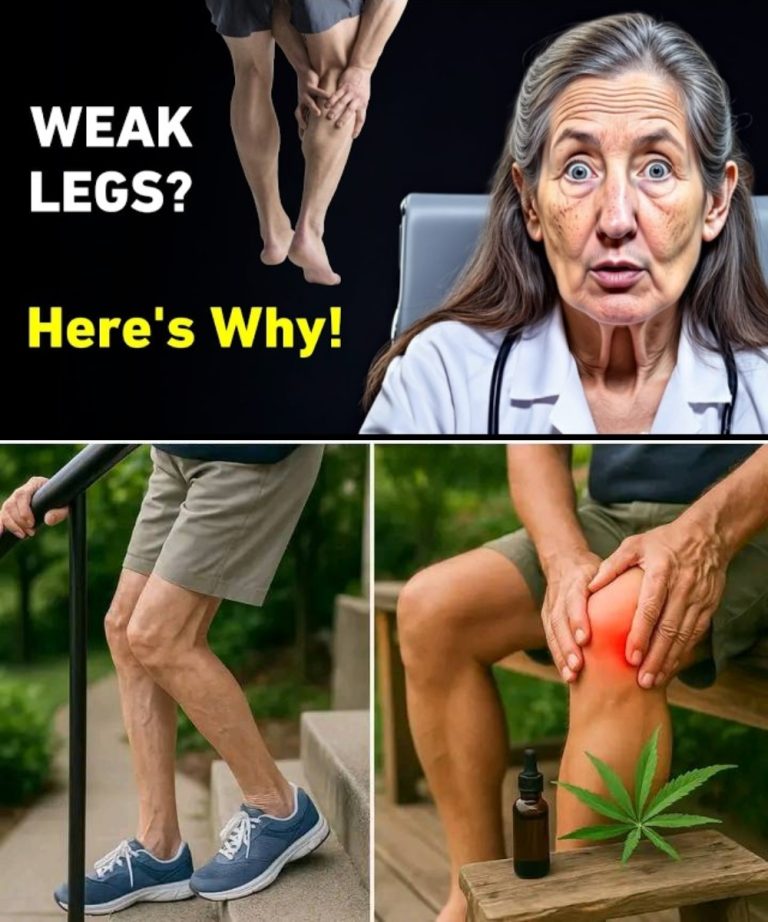Have your legs been feeling heavier, weaker, or more tired than usual? Maybe simple tasks—like climbing stairs or rising from a chair—are becoming a little more difficult.
If so, you’re not alone.
Many people over 60 start to notice changes in leg strength. But here’s the good news: it’s not always “just aging.” In fact, small shifts in your daily routine, nutrition, or movement patterns can quietly affect your muscles—often without you realizing it.
💡 Wellness educator Barbara O’Neill often speaks about how everyday habits can slowly impact strength and balance. In this article, we’ll explore 6 hidden reasons your legs might be feeling weaker—and what you can gently do about it.
1. Not Enough Targeted Leg Movement
🪑 Walking is great, but it's not always enough.
As we age, we naturally lose muscle—a condition called sarcopenia. If we’re not doing specific exercises that activate the thighs, hips, and calves, this muscle loss can happen faster than expected.
What helps:
-
Try 10–15 minutes of leg exercises a few times a week:
-
Sit-to-stand from a firm chair
-
Calf raises at the kitchen counter
-
Seated leg extensions
-
-
Use light ankle weights or resistance bands for gentle challenge
💪 According to research, regular resistance training can slow down age-related muscle loss—and improve overall mobility.
2. Poor Circulation in the Legs
🥶 Do your legs feel cold, crampy, or heavy?
Reduced blood flow—often caused by long sitting periods or circulation issues—can make walking and standing feel much harder. This is more common than many people think.
Watch for signs like:
-
Cold feet or toes
-
Calf cramping during walks
-
Swollen ankles at the end of the day
Simple circulation tips:
-
Elevate your legs when resting
-
Avoid crossing your legs for long periods
-
Do gentle ankle pumps while sitting
-
Take a short walk every hour
🩺 If symptoms persist, talk to your doctor about checking circulation.
3. Low Vitamin D or Calcium
☀️ Weak muscles and thinning bones can often be traced back to low vitamin D or calcium—especially if you spend a lot of time indoors.
These nutrients support muscle function and bone strength, both crucial for leg stability.
What to do:
-
Get 15–20 minutes of safe sunlight (if weather allows)
-
Add calcium-rich foods like:
-
Leafy greens 🥬
-
Fortified plant milks 🥛
-
Dairy or tofu
-
-
Consider a vitamin D supplement after discussing with your doctor
🧠 Studies suggest vitamin D may also reduce fall risk in older adults.
4. Nerve Health May Be Affected
⚡ If your legs feel numb, tingly, or less responsive, nerve function—not just muscle strength—might be involved.
This can be related to:
-
Blood sugar imbalances (like diabetes)
-
B12 deficiency
-
Long-term medication use
Support your nerves by:
-
Managing blood sugar through balanced meals
-
Eating foods rich in B12 (fish, eggs, leafy greens)
-
Getting B12 levels tested—especially on vegetarian diets
📌 Don’t ignore signs like burning or pins-and-needles sensations—talk with your provider.
5. Neglected Balance Muscles
You might have strong thighs—but what about the small muscles around your hips and core?
These "stabilizers" help with balance and quick movement. If they’re underused, everyday tasks can feel harder.
Notice if you:
-
Feel unsteady when turning quickly
-
Need support to stand from a chair
-
Wobble while doing simple movements
Balance-building ideas:
-
Stand on one foot (hold onto a counter if needed)
-
Try gentle yoga or tai chi
-
Do slow side leg lifts
🧘♀️ The National Institute on Aging recommends balance training as a key part of active aging.
6. Not Enough Quality Protein
🍳 Muscle repair and maintenance depend on good protein.
As we get older, our bodies may need more protein—or absorb it less efficiently.
Ask yourself:
-
Do you eat some protein at every meal?
-
Are you getting variety (not just meat)?
Try adding:
-
Greek yogurt or cottage cheese at breakfast
-
Beans or lentils to soups and salads
-
A smoothie with fruit and nut butter
❗If you have kidney concerns, check with your doctor before increasing protein.
A Gentle Plan to Regain Strength 🌿
You don’t need to overhaul your life to feel stronger. Just start with one small step:
-
Choose one reason above that you relate to most
-
Set a gentle goal (like “10 sit-to-stands each morning”)
-
Track your progress once a week and notice changes
You deserve to walk, move, and live with confidence—at any age. Strength doesn’t vanish overnight, and it can often be regained with small, steady habits.
✨ "It's never too late to feel strong again."
✅ Save this post or share it with a loved one who might benefit. Aging doesn’t mean slowing down—it means learning to move smarter, not harder.
Disclaimer: This article is for general information and does not replace medical advice. Please speak with your healthcare provider before making any changes to your routine, especially if you have pre-existing conditions.
